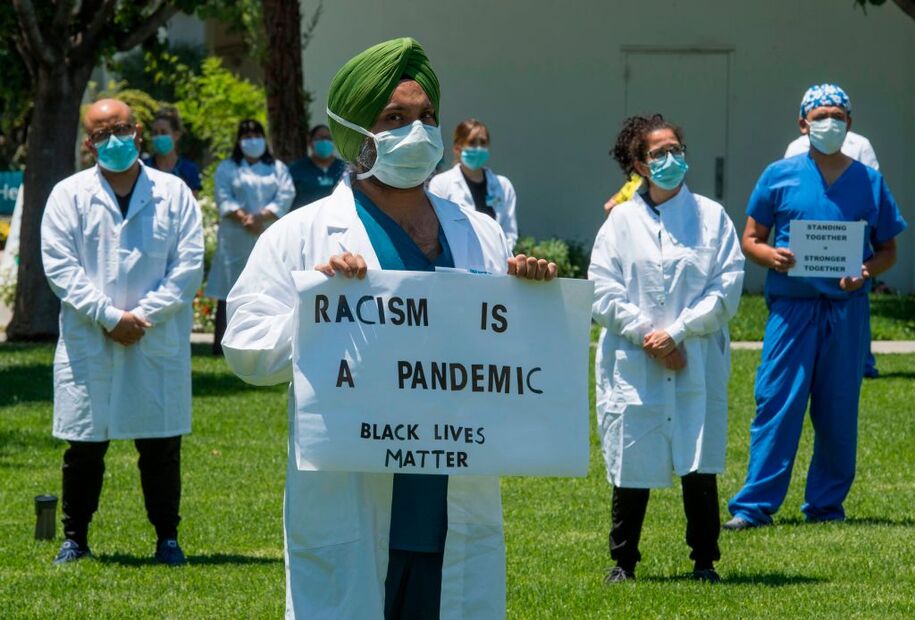This is part two of a two-part series on racism in health care. Read part one here.
The first article in this series highlighted the long history that deep-rooted racism has had in shaping our nation’s health care policies, including why we were never able to obtain universal health care, unlike every other industrialized nation. Our government’s refusal to recognize health care as a fundamental right can be traced back to disturbing racist beliefs, evident in historical attempts to justify denying health care coverage to Black Americans.
In fact, a book commissioned by Prudential Life Insurance, written by a white supremacist in 1896, played a significant role in perpetuating racial biases and influencing legislative efforts against universal health care for over a century. It was no coincidence that the Supreme Court ruled segregation should be legal the same year the book came out. The book, “Race Traits and Tendencies of the American Negro,” argued that health care should be denied to Black Americans since they were prone to disease and would likely die off within three generations if they were simply denied access to health care. The statistics in the book only used race as a factor, ignoring other major issues such as poverty and social neglect.
The issue is that even today, systemic racism continues to stand in the way of equitable health care access, and despite efforts for improvement, racism stands as a primary driver of health inequities, health disparities, and disease. In 2016, a disturbing study published in the New England Journal of Medicine found that many medical students still wrongly believed that Black patients had a higher pain tolerance than nonwhite patients. This myth stemmed from a 19th-century slave owner, Dr. Thomas Hamilton, who convinced the medical establishment that Black skin is “thicker,” made up of fewer nerve endings and hence less sensitive.
The health disparity issue between whites and people of color is massive due to centuries of misinformation and prejudice, but there are solutions.
RELATED STORY: When it comes to our democracy, the message matters
Current Situation
There are numerous studies that show Black people can expect worse outcomes than their white counterparts. In particular, Black women are three times more likely to die from childbirth, even if they are extremely healthy. Olympian Tori Bowie died in childbirth last year at the age of 32, and even Serena Williams nearly died when she gave birth in 2017.
Black infants also have the highest rate of sudden infant death syndrome, and Black mothers are twice as likely not to receive any prenatal care compared to white mothers. One study claimed that the disparities are likely a combination of lack of access to prenatal care and education, but TikTok user Doctor Leslie, points to something entirely different:
“Doctors are to Black women what police officers are to Black men…
If you’ve seen this study, you know that 50% of medical students and residents thought that Black people couldn’t feel pain the same as white people. And we learned from this video that because of a 1999 study there is a “Black correction factor” for the creatinine levels in Black people’s kidneys meaning we are less likely to receive a kidney transplant if needed.
So, if you go to a doctor, and feel you aren’t getting proper treatment or refuse the treatment you requested, say the following: I will need you to document ON RECORD that you are refusing the treatment (or medicine) I’ve requested and the reason you are doing so.”
Throughout the nation, racial and ethnic minority groups consistently grapple with elevated rates of poor health and various conditions—including diabetes, hypertension, obesity, asthma, and heart disease—in stark comparison to their white counterparts. The life expectancy for Black Americans lags four years behind whites. The COVID-19 pandemic only exemplified the disparity: Black, Hispanic, American Indian, and Alaska Native populations had much higher rates of hospitalization and death compared to their white equivalents.

The data is undeniable. A recent investigation underscored the extensive prevalence of racism in our health care system. Spanning almost two decades, researchers analyzed mortality data nationwide, revealing consistently higher mortality rates among Black and Native American populations for nearly all causes of death from 2000 to 2019. (Due to underfunding, pharmacies and doctor’s offices outside of hospitals are completely nonexistent in most Indigenous communities.)
Notably, inequalities were not isolated incidents but pervasive across the country and involving all different kinds of health conditions. The latest findings led by a health management professor at St. Louis University, Dr. Kenton J. Johnston, found that Medicare patients who belong to racial or ethnic minority groups experience the worst access and quality of care involving outpatient medical care.
Johnston said a lot depends on who services the care for minority communities: “If you want to access a good specialist, your choice of cardiologists is going to be different if you live out in the counties that are more affluent versus if you live in the poor areas in northern St. Louis.”
Multiple studies have shown that mistrust of medical professionals by people of color is influenced by this disparity. The mistrust stems from years of racist events, such as the Tuskegee syphilis study, but is reinforced by medical discrimination that continues to this day. (One doctor even pointed out how it’s ingrained in their textbooks.) Recent research from UCLA showed that this current mistrust was the primary reason for such low COVID-19 vaccination rates in the Black community. One of the authors of the study, Kerri Johnson, put it this way: “Characterizing race-related disparities in health care experiences as a relic of the past excludes current medical experiences and absolves the current healthcare system from making needed change.”
Representation matters
The question becomes what to do about it. The first and best place to start is representation, meaning we need to have more minority doctors. Studies have shown that people of color are much less likely to report trust in their physicians and are thus less likely to seek treatment.
Having a doctor that looks like you and/or comes from your shared background provides comfort, trust, and a better understanding of where you’re coming from. Yet this has been a challenge. For example, the Association of American Medical Colleges shows that less than 6% of all doctors are Black, despite being close to 14% of the overall population. Having so few has been a big issue.
Yet the AAMC says the investment is worth it:
Studies show that having a doctor with the same race or ethnicity improves outcomes, including time spent together, medication adherence, shared decision-making, wait times for treatment, cholesterol screening, patient understanding of cancer risk, and patient perceptions of treatment decisions.
There are challenges in obtaining more Black doctors, with one of the top issues being financial due to structural inequalities. Most medical students have an average debt of nearly $165,800 upon graduation, which is a massive burden. Medical schools can and should offer full scholarships to eligible minority applicants. Many scholarships, however, only offer a couple thousand dollars in aid. (This year, a medical school in the Bronx was gifted $1 billion by a generous benefactor, allowing all medical students to attend the school for free.)
Penn’s medical school partnered with several HBCUs to attract more Black students into medicine, and to their credit, they created a program that, if completed, allows entry without having to take the Medical College Admissions Test (MCAT). This test is not only extremely expensive, but also requires expensive tutoring and prep that only wealthier students can afford. There is a growing movement for the Association of American Medical Colleges to follow the lead of the American Bar Association, which recently voted to eliminate the Law School Admission Test (LSAT) as an admissions requirement for law schools in an effort to increase diversity.
awareness of diversity issues
The second place to start is having awareness of the problem and taking measures to deal with it. Several academic medical centers are proactively developing tools to identify and address racism within their policies and practices. The University of California Los Angeles Health has taken the lead with the development of equity dashboards that detect variations in patients’ health care quality based on factors such as race, ethnicity, gender identity, age, sexual orientation, and community-level social vulnerability.

These dashboards also monitor the health system’s hiring, promotion, training, and contracting practices, including metrics on patient and employee grievances, promotions, and vendors. Moreover, UCLA is revamping the collection of race and ethnicity data, allowing patients to self-identify rather than relying on staff assumptions.
Penn Medicine has also taken steps to address racism within its workplace by encouraging staff to report incidents through a digital platform called Lift Every Voice. This platform, currently being piloted in two emergency departments, enables anonymous reporting of unfair treatment or discriminatory actions, fostering a culture of accountability and transparency.
Similarly, UCLA has implemented a real-time reporting system for students, staff, and clinicians to report incidents of racist and discriminatory behavior. These initiatives aim to create mechanisms for employees and patients to voice concerns, track reported incidents, identify patterns, and implement broader interventions to cultivate inclusive and anti-racist workplace cultures.
minority representation in leadership positions
Third, there needs to be more minority representation in leadership roles. If there are no people of color in leadership roles, then it is unlikely that there will be major policy changes. Having representation at the top can embolden and hasten change. However, despite comprising around 39% of the U.S. population in 2019, Black and other racial minority groups constituted only 19% of hospital boards and only 16% of executive leadership positions.
To enhance diversity, University of Chicago Medicine revamped its leadership recruitment strategy in the fiscal year 2020–21. Instead of solely relying on recruitment firms, the institution requested information from firms with a proven track record of placing diverse candidates. This change resulted in a modest increase from 22% to 23% of senior leaders of color. Clearly, more needs to be done in this area.
calling out racist literature
Finally, there needs to be an overhaul in the training of academic medicine. Interestingly, much of the reform so far has been driven by the medical students themselves. They’ve called out racist textbooks, like this nursing textbook from 2015 that said Black patients lie about their pain or this one used by Jeremy Chapman, M.D., which gave scenarios where the imaginary white patients were portrayed as smarter and more responsible than the imaginary Black patients.

At Boston University School of Medicine, students dedicated over a year to scrutinizing syllabi, lecture slides, course documents, and exam questions to identify embedded racist assumptions in the curriculum. Their efforts resulted in a comprehensive 137-page report suggesting ways to seamlessly integrate learning opportunities about racism and health throughout the medical school experience.
Last June, at the University of Pittsburgh, Black medical students urged the dean to address racial inequities, emphasizing the need to recruit Black students from the local community. The medical school responded by establishing two full annual scholarships for Black medical students and two college scholarships for Pittsburgh high school students. The Pitt News reported:
“We really just wanted to come together and demand a change from our university,” Tompkins-Rhoades, a primary author of the demands, said. “We wanted a safe space here, on the campus of the University of Pittsburgh, for Black students to feel safe and supported.”
A working group was formed to explore effective support for Black community members. According to Utibe Essien, M.D., M.P.H., from the University of Pittsburgh, community investment is crucial, starting from high schools and undergraduates to cultivate diversity. Otherwise, the results can be devastating. “For patients with atrial fibrillation, long-term oral anticoagulant use can reduce their risk of stroke. Even after our analysis adjusted for socioeconomic factors, Black patients were still less likely to receive these types of drugs.”
change means action
These efforts have led to some success. At The Ohio State University College of Medicine, 25% of students come from underrepresented racial or ethnic groups. The medical school admissions committee at OSU incorporates the race implicit association test (IAT), revealing unconscious biases. A 2013 study found that all groups, including men, women, students, and faculty exhibited some level of unconscious bias in favor of whites, with the strongest bias observed among men and faculty. To reduce racial bias in admissions, the committee aimed to include more Black members, women, and medical students. The first class after implementing the IAT was Ohio State’s most racially diverse, possibly due to enhanced connections with admissions committee members.
Change means action, and action means making investments to combat the multiple root causes of health disparities faced by racial and ethnic minority groups. This means investing in scholarship programs for diverse medical professionals, investing in monitoring programs, investing in training, and investing in the time and resources it will take to reform medical school curricula and foster leadership that will actively tackle these systemic challenges.
Crucially, these endeavors should be accompanied by firm commitments to bring about change. Without such commitments, individuals who have endured discrimination, both as patients and professionals, will rightfully maintain a level of skepticism toward declarations of improvement.
“We’re tired of words,” says Brenda Battle, R.N., of the University of Chicago Medicine. “Everybody’s tired of words.”
RELATED STORY: ‘This was intentional’: AOC blasts Republicans on IVF ruling
#Racism #todays #health #care #fight




















+ There are no comments
Add yours